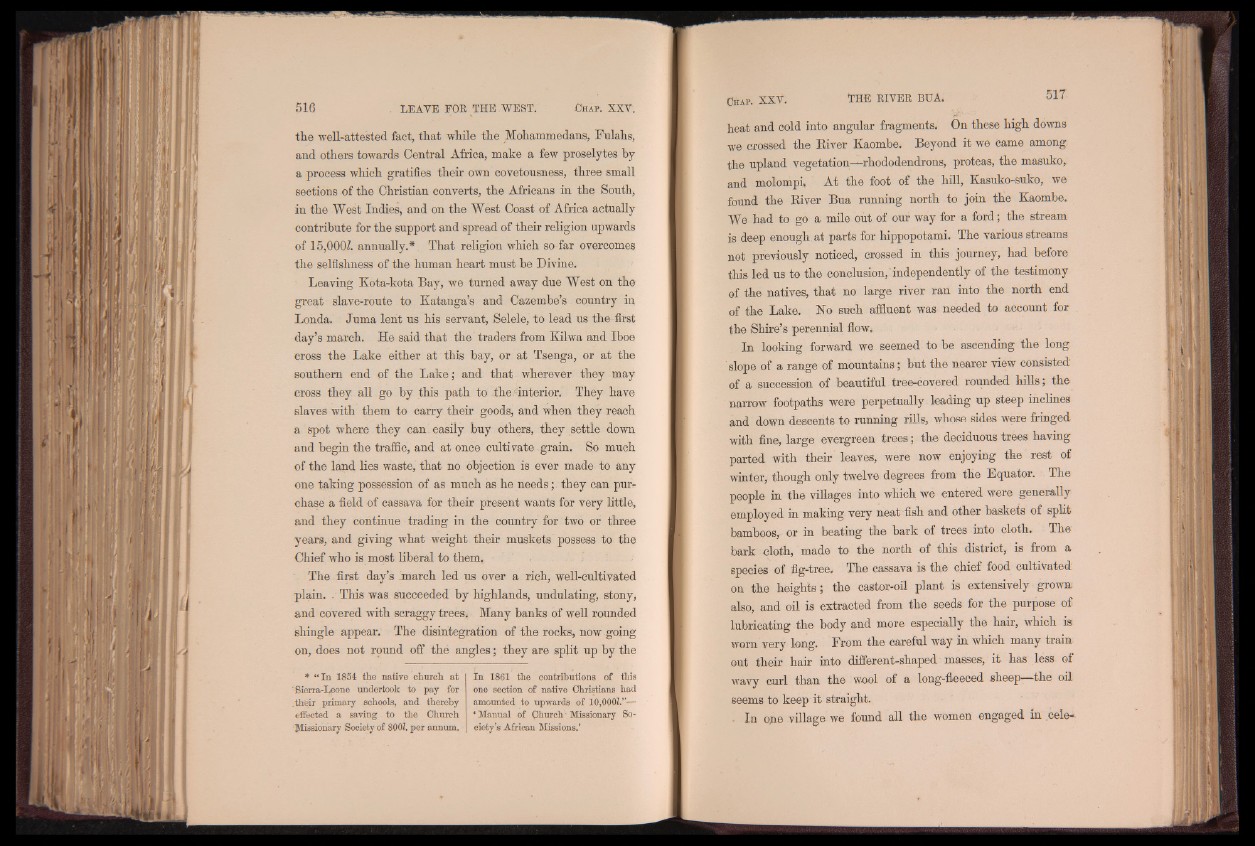
the well-attested fact, that while the Mohammedans, Fulahs,
and others towards Central Africa, make a few proselytes hy
a process which gratifies their own covetousness, three small
sections of the Christian converts, the Africans in the South,
in the West Indies, and on the West Coast of Africa actually
contribute for the support and spread of their religion upwards
of 15,000?. annually.* That religion which so far overcomes
the selfishness of the human heart must be Divine.
Leaving Kota-kota Bay, we turned away due West on the
great slave-route to Katanga’s and Cazembe’s country in
Londa. Juma lent us his servant, Selele, to lead us the first
day’s march. He said that the traders from Kilwa and Iboe
cross the Lake either at this bay, or at Tsenga, or at the
southern end of the Lake; and that wherever they may
cross they all go by this path to th e ‘ interior. They have
slaves with them to carry their goods, and when they reach
a spot where they can easily buy others, they settle down
and begin the traffic, and at once cultivate grain. So much
of the land lies waste, that no objection is ever made to any
one taking possession of as much as he needs; they can purchase
a field of cassava for their present wants for very little,
and they continue trading in the country for two or three
years, and giving what weight their muskets possess to the
Chief who is most liberal to them.
The first day’s .march led us over a rich, well-cultivated
plain. . This was succeeded by highlands, undulating, stony,
and covered with scraggy trees. Many banks of well rounded
shingle appear. The disintegration of the rocks, now going
on, does not rpund off the angles; they are split up by the
* “ In 1854 the native church at
In 1861 the contributions of this
Sierra-Leone undertook to pay for
one section of native Christians had
their primary schools, and thereby
amounted to upwards of ÎO.OOOÏ.”—
effected a saving to the Church
‘ Manual of Church ' Missionary Society's
Missionary Society of SOW. per annum.
African Missions.’
heat and cold into angular fragments. On these high downs
we crossed the River Kaombe. Beyond it we came among
the upland vegetation—rhododendrons, proteas, the masuko,
and molompi, At the foot of the hill, Kasuko-suko, we
found the River Bua running north to join the Kaombe.
We had to go a mile out of our way for a ford; the stream
is deep enough at parts for hippopotami. The various streams
not previously noticed, crossed in this journey, had before
this led us to the conclusion, independently of the testimony
of the natives, that no large river ran into the north end
of the Lake. No such affluent was needed to account for
the Shire’s perennial flow.
In looking forward we seemed to be ascending the long
slope of a range of mountains; but the nearer view consisted
of a succession of beautiful tree-covered rounded hills; the
narrow footpaths were perpetually leading up steep inclines
and down descents to running rills, whose sides were fringed
with fine, large evergreen trees | the deciduous trees having
parted with their leaves, were now enjoying the rest of
winter, though only twelve degrees from the Equator. The
people in the villages into which we entered were generally
employed in making very neat fish and other baskets of split
bamboos, or in beating the bark of trees into cloth. The
bark cloth, made to the north of this district, is from a
species of fig-tree, The cassava is the chief food cultivated
on the heights; the castor-oil plant is extensively grown
also, and oil is extracted from the seeds for the purpose of
lubricating the body and more especially the hair, which is
worn very long. From the careful way in which many train
out their hair into different-shaped masses, it has less of
wavy curl than the wool of a long-fleeced sheep—the oil
seems to keep it straight.
In ope village we found all the women engaged in cele-*-